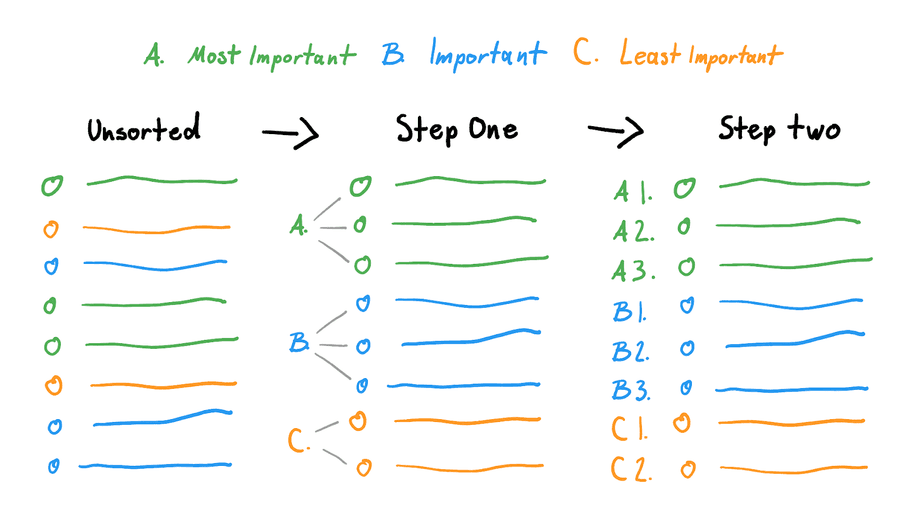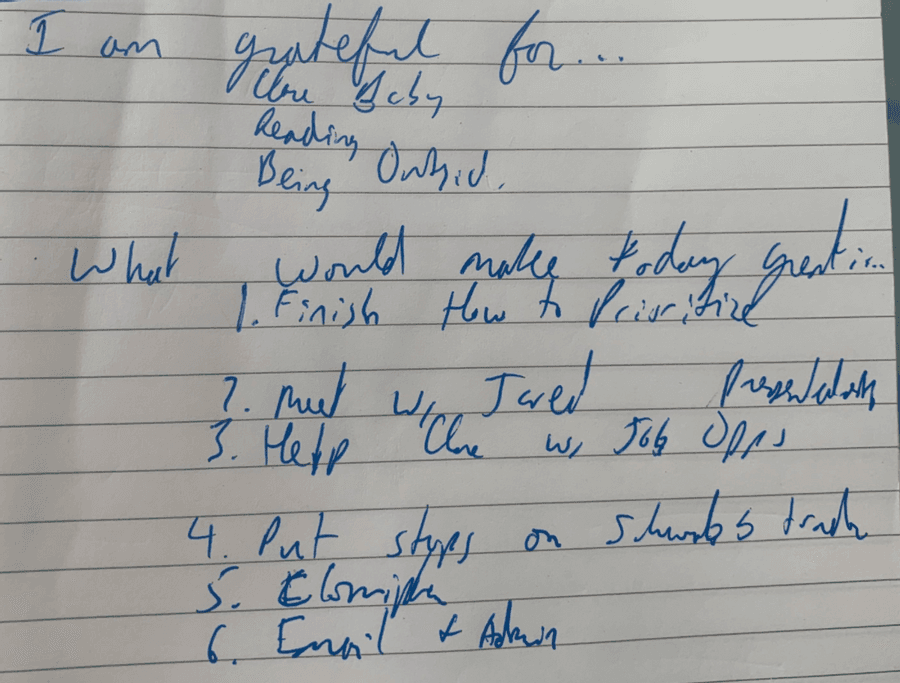How to Prioritize Work Tasks: The Ultimate Guide to Priority Management
Curated from: taylorpearson.me
Ideas, facts & insights covering these topics:
11 ideas
·58.7K reads
132
1
Explore the World's Best Ideas
Join today and uncover 100+ curated journeys from 50+ topics. Unlock access to our mobile app with extensive features.
Personal Operations Category
- Task management. This one is most commonly taught and includes systems like Getting Things Done.
- Knowledge management. This is embodied in systems like productivity educator Tiago Forte's Building a Second Brain.
- Priority management. Without this category, the first two will fail. You need to have your tasks and resources organized, but also know how to prioritize them.
2.9K
11.5K reads
What's on your plate
Prioritizing tasks at work involves getting all your tasks and commitments in one place. Take a piece of paper and make a list of everything you need to get done. Questions to help you:
- Do you have commitments to others like your boss, partner, kids, or clients?
- Do you have anything you need to submit?
- Do you have any financial tasks that need to get done?
- Do you have any planning that needs to get done?
- Do you have any administrative tasks? Legal, insurance, staffing, or training?
- Do you have any professional development tasks that need to get done? Training, areas to research, skills to develop, books to read or study, or classes to take?
2.82K
5.53K reads
Brainstorm your goals
Find your goals. Without them, it is impossible to prioritize your tasks. Try to set 90-day goals, which is long enough to make meaningful progress. Questions to prompt goals:
- What’s the one thing you could do that makes everything else easier or unnecessary?
- If you were giving advice to someone else in your position, what 1-3 things would you tell them to focus on?
- What do you want to have accomplished over the next five years?
2.93K
5.41K reads
Your Top 1-3 Goals
Prioritize your list of possible goals using and expected value (EV) calculation. Expected Value = Resources Required x Return on Investment x Probability of Success
Take the list of everything you could potentially work on over the next 90 days and then rank them by these criteria.
- Resources required: This is your time and cash required.
- Probability of success: How likely it is to work and how excited you are about it.
- Return on Investment (ROI): Your 1 Year and 5 Year ROI. Some projects have quick payback periods, and others have long term ones. Try and keep a balance by having one long and one short term ROI.
2.8K
4.38K reads
The ABCDE Method
This method consists of ranking your tasks into five categories.
- A – Very important, must be done at all costs.
- B – Pretty important, but the consequences aren’t as serious if it’s not completed.
- C – It would be nice to have done, but with no consequences for not doing it.
- D – Delegate this to someone else as it's not worth your time.
- E – Eliminate. Not worth doing, delete it.
3.39K
7.15K reads
Eisenhower Priority Matrix
The priority matrix allows you to look through your to-do list and categorize based on their urgency and importance.
- Quadrant 1 - Urgent and important. This is anything due soon or overdue. See what can be automated or delegated.
- Quadrant 2 - Not urgent and important. This contains tasks that are beneficial to your career or business in the long run.
- Quadrant 3 - Urgent, not important.
- Quadrant 4 - Not urgent, not important. Everything else goes here.
2.79K
4.17K reads
The Marshall Matrix
Categorize your tasks by how much value they generate for you or your company. Tasks can be assigned as either $10/hour, $100/hour, $1,000/hour or $10,000/hour.
We might think of the value of the tasks as linear, where some tasks are more important than others. But the difference in value can be huge. For example, one new product could dramatically grow the business while the minor website update might make a negligent difference.
2.55K
3.64K reads
The Not-To-Do List
Some examples of things that often waste time:
- Checking business stats (traffic, sales) every day if there is nothing actionable to be done with them.
- Going back and forth in an email thread more than once in a day
- Meetings before noon or without a clear agenda
- Errands that can be outsourced
- Social Media and Email on Phone
- Responding to Emails more than twice a day
- Micromanaging people instead of managing by KPIs and results
2.72K
4.43K reads
Prioritize by Energy Level
- Maker Time: Maker work requires long amounts of uninterrupted time, like coding, designing or writing. The peak energy part of your day is most suited for this.
- Manager Work: This work needs to be done, but does not drive things forward, like meetings, email, or filling out tax forms. It is best to "chunk" this time too and do it after your Maker work.
- Admin Work: This is work you can do when you feel otherwise brain dead, like organizing your office or data entry.
2.8K
4.05K reads
The Beginning of Each Week
Update all the tasks on your list and prioritize them. Then put them on your calendar based around your energy levels. Ask "Given my current energy level, what's the most valuable task I can do now?
- First put your rest in your schedule, because it is the easiest to neglect.
- Then add your exercise times. It's so easy to skimp on if not scheduled in.
- Next, add the high priority work (Maker work or $1,000 - $10,000/hour work.)
- Then add your learning.
- Finally, add the manager and admin or $10 - $100 work.
2.72K
3.68K reads
Schedule Your Day
At the start of each day, look over your calendar and task list for that day, and quickly write down three things you are grateful for your priorities of the day.
Writing on paper makes it less likely to keep adding as the day progresses. Crossing the tasks off as you complete them feels very satisfying.
2.57K
4.71K reads
IDEAS CURATED BY
Xander A.'s ideas are part of this journey:
Learn more about timemanagement with this collection
How to overcome unwanted thoughts
How to manage intrusive thoughts
How to change your attitude towards intrusive thoughts
Related collections
Similar ideas
Read & Learn
20x Faster
without
deepstash
with
deepstash
with
deepstash
Personalized microlearning
—
100+ Learning Journeys
—
Access to 200,000+ ideas
—
Access to the mobile app
—
Unlimited idea saving
—
—
Unlimited history
—
—
Unlimited listening to ideas
—
—
Downloading & offline access
—
—
Supercharge your mind with one idea per day
Enter your email and spend 1 minute every day to learn something new.
I agree to receive email updates


